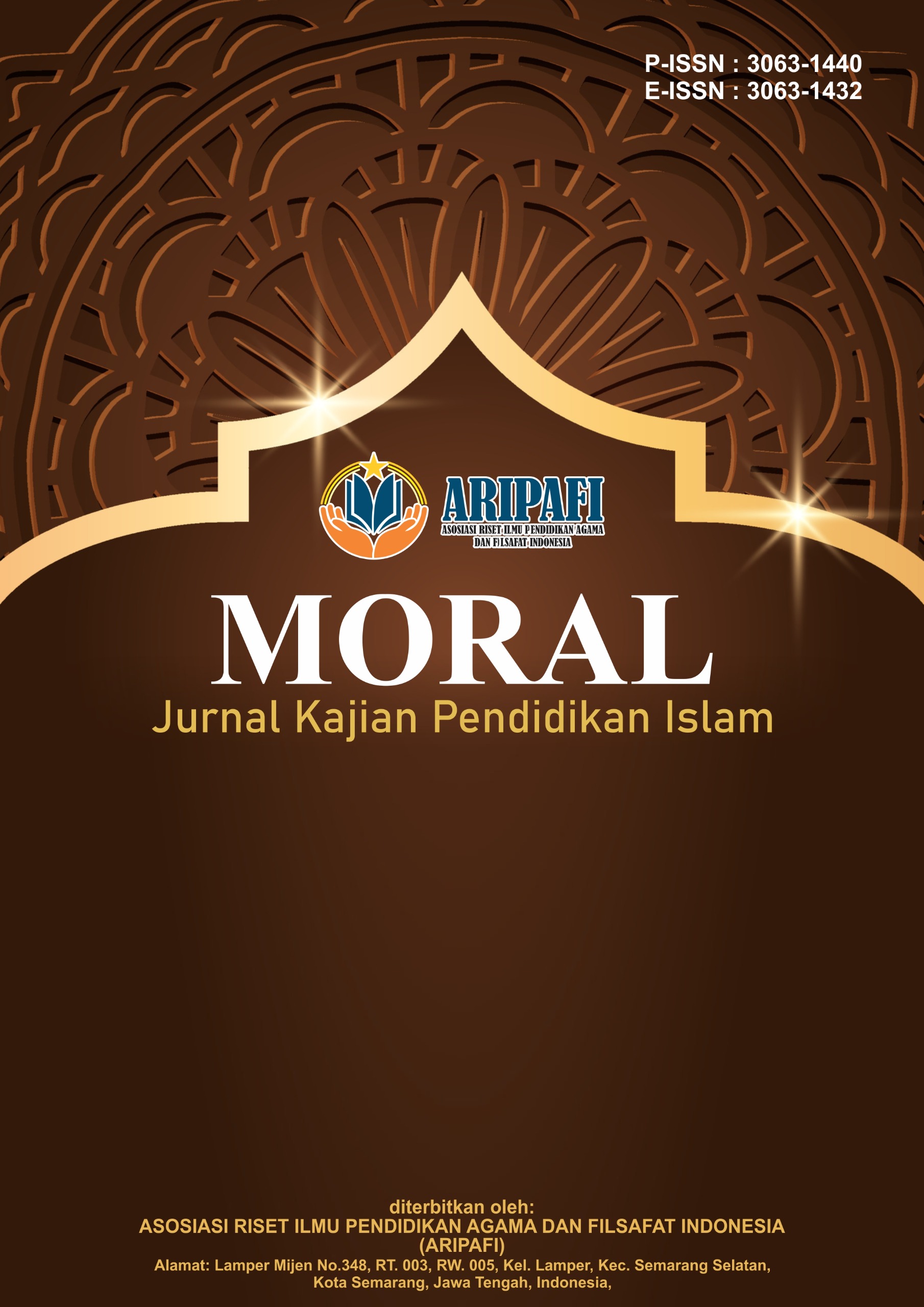Efektivitas Metode Scramble untuk Meningkatkan Hasil Belajar Bahasa Arab Siswa Kelas X MA Takhassus Al-Qur’an Wonosobo
DOI:
https://doi.org/10.61132/moral.v2i2.876Keywords:
Scramble Method, Learning Outcomes, ArabicAbstract
The purpose of this study was to analyze the effectiveness of the scramble method to improve the Arabic language learning outcomes of class X students of MA Takhassus AlQur'an Wonosobo. The article is a quantitative field research with an experimental approach. The research was conducted during the months of March to May 2025, involving 54 respondents as samples including control and experimental classes, taking data from observations, tests, interviews, and documentation. The results of the research showed that the application of the Scramble learning method had been carried out according to the learning implementation plan, using pre-tests and post-tests in the experimental class went well and received positive responses from students. There was an increase in students' Arabic language learning outcomes after applying the method in the experimental class, as evidenced by the results of the hypothesis with a gain test obtained a result of 0.624 (high category), the control class obtained a gain test result of 0.079 (moderate category). Real effectiveness can improve learning outcomes proven through t-test calculations obtained t_count results of 11.591 and t_table of 2.006 at a 5% error level and 2.673 at a 1% error level with dk = 27 + 27-2 = 52. This finding strengthens the Scramble method can be considered to improve student learning outcomes. Research recommends that in the teaching and learning process, it is possible to plan and consider various methods in learning so that students feel interested and not bored..
References
Amin, N. F., Garancang, S., & Abunawas, K. (2023). Konsep umum populasi dan sampel dalam penelitian. PILAR, 4(1), 15–31.
Anuraga, G., Indrasetianingsih, A., & Athoillah, M. (2021). Pelatihan pengujian hipotesis statistika dasar dengan software R. Budimas: Jurnal Pengabdian Masyarakat, 3(2), 327–334. https://doi.org/10.29040/budimas.v3i2.2412
Baroroh, R. U., & Rahmawati, F. N. (2020). Metode-metode dalam pembelajaran keterampilan Bahasa Arab reseptif. Urwatul Wutsqo: Jurnal Studi Kependidikan dan Keislaman, 9(2), 179–196. https://doi.org/10.54437/urwatulwutsqo.v9i2.181
El-Syam, R. S. (2019). Al-Qur’an sebagai sumber pembaharuan peradaban manusia. Manarul Qur’an: Jurnal Ilmiah Studi Islam, 19(2), 74–81. https://doi.org/10.32699/mq.v19i2.1604
Syahroni, M. I. (2022). Prosedur penelitian kuantitatif. EJurnal Al Musthafa, 2(3), 43–56. https://doi.org/10.62552/ejam.v2i3.50
Judiyyi, M. A. Q. A., El Syam, R. S., & Imron, A. (2024). Penerapan metode imla’ dengan buku Hayya Nata’allamu Imla’ untuk meningkatkan penguasaan maharah kitabah santri kelas VIII Program Tahfidz SMP PPTQ Al Asy’ariyyah Kalibeber Wonosobo tahun ajaran 2022/2023. Journal of Student Research, 2(4), 198–207. https://doi.org/10.55606/jsr.v2i4.3167
Khumaedi, M. (2012). Reliabilitas instrumen penelitian pendidikan. Jurnal Pendidikan Teknik Mesin, 12(1), 25–30. https://doi.org/10.15294/jptm.v12i1.5273
Komarudin. (2025, April 16). Hasil wawancara dengan guru mata pelajaran Bahasa Arab MA Takhassus Al-Qur’an Wonosobo [Wawancara]. Ruang Guru MA Takhassus Al-Qur’an Wonosobo.
Larasati, P., Putrayasa, I. B., & Dewantara, I. P. M. (2024). Penerapan model scramble dalam pembelajaran teks berita Bahasa Indonesia. Nusantara: Jurnal Pendidikan Indonesia, 4(2), 437–450. https://doi.org/10.14421/njpi.2024.v4i2-8
Magdalena, R., & Krisanti, M. A. (2019). Analisis penyebab dan solusi rekonsiliasi Finished Goods menggunakan hipotesis statistik dengan metode pengujian independent sample t-test di PT. Merck, Tbk. Jurnal Tekno, 16(2), 35–48. https://doi.org/10.33557/jtekno.v16i1.623
Moleong, L. J. (2021). Metodologi penelitian kualitatif. Remaja Rosdakarya.
Sianturi, R. (2022). Uji homogenitas sebagai syarat pengujian analisis. Jurnal Pendidikan, Sains Sosial, dan Agama, 8(1), 386–397. https://doi.org/10.53565/pssa.v8i1.507
Slamet, R., & Wahyuningsih, S. (2022). Validitas dan reliabilitas terhadap instrumen kepuasan kerja. Aliansi Jurnal Manajemen dan Bisnis, 17(2), 51–58. https://doi.org/10.46975/aliansi.v17i2.428
Sugiyono. (2022). Metode penelitian kuantitatif, kualitatif, dan R&D. Alfabeta.
Sukarelawa, M. I., Indratno, T. K., & Ayu, S. M. (2024). N-Gain vs Stacking: Analisis perubahan abilitas peserta didik dalam desain one group pretest-posttest. Suryacahya.
Suryani, I., Bakiyah, H., & Isnaeni, M. (2020). Strategi public relations PT Honda Megatama Kapuk dalam customer relations. Journal Komunikasi, 11(2), 101–110. https://doi.org/10.31294/jkom.v11i2
Taylor, R. B. (2001). Learning to scramble. Family Medicine, 38(8), 629–630. https://www.researchgate.net/publication/11774102
Widana, I. W., & Muliani, N. P. L. (2020). Uji persyaratan analisis (T. Fiktorius, Ed.). Klik Media.
Zulfa, I., & El Syam, R. S. (2024). Implementasi metode imla’ manqul dalam meningkatkan kemampuan menulis huruf Arab di TPQ Tanwirut-Thullab Panikel, Kampung Laut, Cilacap. Jurnal Manajemen dan Pendidikan Agama Islam, 2(4), 240–248. https://doi.org/10.61132/jmpai.v2i4.404
Downloads
Published
How to Cite
Issue
Section
License
Copyright (c) 2025 Moral : Jurnal kajian Pendidikan Islam

This work is licensed under a Creative Commons Attribution-ShareAlike 4.0 International License.






